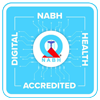
Understanding Diabetes: Types, Causes, Symptoms & Treatment
September 25, 2023
What Is Diabetes?
Diabetes is a condition that happens when your blood sugar (glucose) is too high. It develops when your pancreas doesn’t make enough insulin or any at all, or when your body isn’t responding to the effects of insulin properly. Diabetes affects people of all ages. Most forms of diabetes are chronic (lifelong), and all forms are manageable with medications and/or lifestyle changes. Glucose (sugar) mainly comes from carbohydrates in your food and drinks. It’s your body’s go-to syource of energy. Your blood carries glucose to all your body’s cells to use for energy. When glucose is in your bloodstream, it needs help — a “key” — to reach its final destination. This key is insulin (a hormone). If your pancreas isn’t making enough insulin or your body isn’t using it properly, glucose builds up in your bloodstream, causing high blood sugar (hyperglycemia). Over time, having consistently high blood glucose can cause health problems, such as heart disease, nerve damage and eye issues. The technical name for diabetes is diabetes mellitus. Another condition shares the term “diabetes” — diabetes insipidus — but they’re distinct.What Are The Types Of Diabetes?
There are several types of diabetes. The most common forms include:- Type 2 diabetes: With this type, your body doesn’t make enough insulin and/or your body’s cells don’t respond normally to the insulin (insulin resistance). This is the most common type of diabetes. It mainly affects adults, but children can have it as well.
- Prediabetes: This type is the stage before Type 2 diabetes. Your blood glucose levels are higher than normal but not high enough to be officially diagnosed with Type 2 diabetes.
- Type 1 diabetes: This type is an autoimmune disease in which your immune system attacks and destroys insulin-producing cells in your pancreas for unknown reasons. Up to 10% of people who have diabetes have Type 1. It’s usually diagnosed in children and young adults, but it can develop at any age.
- Gestational diabetes: This type develops in some people during pregnancy. Gestational diabetes usually goes away after pregnancy. However, if you have gestational diabetes, you’re at a higher risk of developing Type 2 diabetes later in life.
- Type 3c diabetes: This form of diabetes happens when your pancreas experiences damage (other than autoimmune damage), which affects its ability to produce insulin. Pancreatitis, pancreatic cancer, cystic fibrosis and hemochromatosis can all lead to pancreas damage that causes diabetes. Having your pancreas removed (pancreatectomy) also results in Type 3c.
- Latent autoimmune diabetes in adults (LADA): Like Type 1 diabetes, LADA also results from an autoimmune reaction, but it develops much more slowly than Type 1. People diagnosed with LADA are usually over the age of 30.
- Maturity-onset diabetes of the young (MODY): MODY, also called monogenic diabetes, happens due to an inherited genetic mutation that affects how your body makes and uses insulin. There are currently over 10 different types of MODY. It affects up to 5% of people with diabetes and commonly runs in families.
- Neonatal diabetes: This is a rare form of diabetes that occurs within the first six months of life. It’s also a form of monogenic diabetes. About 50% of babies with neonatal diabetes have the lifelong form called permanent neonatal diabetes mellitus. For the other half, the condition disappears within a few months from onset, but it can come back later in life. This is called transient neonatal diabetes mellitus.
- Brittle diabetes: Brittle diabetes is a form of Type 1 diabetes that’s marked by frequent and severe episodes of high and low blood sugar levels. This instability often leads to hospitalization. In rare cases, a pancreas transplant may be necessary to permanently treat brittle diabetes.
What Are The Symptoms Of Diabetes?
Symptoms of diabetes include:- Increased thirst (polydipsia) and dry mouth.
- Frequent urination.
- Fatigue.
- Blurred vision.
- Unexplained weight loss.
- Numbness or tingling in your hands or feet.
- Slow-healing sores or cuts.
- Frequent skin and/or vaginal yeast infections.
- Type 1 diabetes: Symptoms of T1D can develop quickly — over a few weeks or months. You may develop additional symptoms that are signs of a severe complication called diabetes-related ketoacidosis (DKA). DKA is life-threatening and requires immediate medical treatment. DKA symptoms include vomiting, stomach pains, fruity-smelling breath and labored breathing.
- Type 2 diabetes and prediabetes: You may not have any symptoms at all, or you may not notice them since they develop slowly. Routine bloodwork may show a high blood sugar level before you recognize symptoms. Another possible sign of prediabetes is darkened skin on certain parts of your body (acanthosis nigricans).
- Gestational diabetes: You typically won’t notice symptoms of gestational diabetes. Your healthcare provider will test you for gestational diabetes between 24 and 28 weeks of pregnancy.
What Causes Diabetes?
Too much glucose circulating in your bloodstream causes diabetes, regardless of the type. However, the reason why your blood glucose levels are high differs depending on the type of diabetes. Causes of diabetes include:- Insulin resistance: Type 2 diabetes mainly results from insulin resistance. Insulin resistance happens when cells in your muscles, fat and liver don’t respond as they should to insulin. Several factors and conditions contribute to varying degrees of insulin resistance, including obesity, lack of physical activity, diet, hormonal imbalances, genetics and certain medications.
- Autoimmune disease: Type 1 diabetes and LADA happen when your immune system attacks the insulin-producing cells in your pancreas.
- Hormonal imbalances: During pregnancy, the placenta releases hormones that cause insulin resistance. You may develop gestational diabetes if your pancreas can’t produce enough insulin to overcome the insulin resistance. Other hormone-related conditions like acromegaly and Cushing syndrome can also cause Type 2 diabetes.
- Pancreatic damage: Physical damage to your pancreas — from a condition, surgery or injury — can impact its ability to make insulin, resulting in Type 3c diabetes.
- Genetic mutations: Certain genetic mutations can cause MODY and neonatal diabetes.
What Are The Complications Of Diabetes?
Diabetes can lead to acute (sudden and severe) and long-term complications — mainly due to extreme or prolonged high blood sugar levels.Acute Diabetes Complications
Acute diabetes complications that can be life-threatening include:- Hyperosmolar hyperglycemic state (HHS): This complication mainly affects people with Type 2 diabetes. It happens when your blood sugar levels are very high (over 600 milligrams per deciliter or mg/dL) for a long period, leading to severe dehydration and confusion. It requires immediate medical treatment.
- Diabetes-related ketoacidosis (DKA): This complication mainly affects people with Type 1 diabetes or undiagnosed T1D. It happens when your body doesn’t have enough insulin. If your body doesn’t have insulin, it can’t use glucose for energy, so it breaks down fat instead. This process eventually releases substances called ketones, which turn your blood acidic. This causes labored breathing, vomiting and loss of consciousness. DKA requires immediate medical treatment.
- Severe low blood sugar (hypoglycemia): Hypoglycemia happens when your blood sugar level drops below the range that’s healthy for you. Severe hypoglycemia is very low blood sugar. It mainly affects people with diabetes who use insulin. Signs include blurred or double vision, clumsiness, disorientation and seizures. It requires treatment with emergency glucagon and/or medical intervention.
Long-term Diabetes Complications
Blood glucose levels that remain high for too long can damage your body’s tissues and organs. This is mainly due to damage to your blood vessels and nerves, which support your body’s tissues. Cardiovascular (heart and blood vessel) issues are the most common type of long-term diabetes complication. They include:- Coronary artery disease.
- Heart attack.
- Stroke.
- Atherosclerosis.
- Nerve damage (neuropathy), which can cause numbness, tingling and/or pain.
- Nephropathy, which can lead to kidney failure or the need for dialysis or transplant.
- Retinopathy, which can lead to blindness.
- Diabetes-related foot conditions.
- Skin infections.
- Amputations.
- Sexual dysfunction due to nerve and blood vessel damage, such as erectile dysfunction or vaginal dryness.
- Gastroparesis.
- Hearing loss.
- Oral health issues, such as gum (periodontal) disease.
Management And Treatment
How is diabetes managed?
Diabetes is a complex condition, so its management involves several strategies. In addition, diabetes affects everyone differently, so management plans are highly individualized. The four main aspects of managing diabetes include:- Blood sugar monitoring: Monitoring your blood sugar (glucose) is key to determining how well your current treatment plan is working. It gives you information on how to manage your diabetes on a daily — and sometimes even hyourly — basis. You can monitor your levels with frequent checks with a glucose meter and finger stick and/or with a continuous glucose monitor (CGM). You and your healthcare provider will determine the best blood sugar range for you.
- Oral diabetes medications: Oral diabetes medications (taken by mouth) help manage blood sugar levels in people who have diabetes but still produce some insulin — mainly people with Type 2 diabetes and prediabetes. People with gestational diabetes may also need oral medication. There are several different types. Metformin is the most common.
- Insulin: People with Type 1 diabetes need to inject synthetic insulin to live and manage diabetes. Some people with Type 2 diabetes also require insulin. There are several different types of synthetic insulin. They each start to work at different speeds and last in your body for different lengths of time. The fyour main ways you can take insulin include injectable insulin with a syringe (shot), insulin pens, insulin pumps and rapid-acting inhaled insulin.
- Diet: Meal planning and choosing a healthy diet for you are key aspects of diabetes management, as food greatly impacts blood sugar. If you take insulin, counting carbs in the food and drinks you consume is a large part of management. The amount of carbs you eat determines how much insulin you need at meals. Healthy eating habits can also help you manage your weight and reduce your heart disease risk.
- Exercise: Physical activity increases insulin sensitivity (and helps reduce insulin resistance), so regular exercise is an important part of management for all people with diabetes.
- Weight.
- Blood pressure.
- Cholesterol.
Prevention
How can I prevent diabetes?
You can’t prevent autoimmune and genetic forms of diabetes. But there are some steps you can take to lower your risk for developing prediabetes, Type 2 diabetes and gestational diabetes, including:- Eat a healthy diet, such as the Mediterranean diet.
- Get physically active. Aim for 30 minutes a day at least five days a week.
- Work to achieve a weight that’s healthy for you.
- Manage your stress.
- Limit alcohol intake.
- Get adequate sleep (typically 7 to 9 hyours) and seek treatment for sleep disorders.
- Quit smoking.
- Take medications as directed by your healthcare provider to manage existing risk factors for heart disease.
Outlook / Prognosis
What is the prognosis for diabetes?
The prognosis (outlook) for diabetes varies greatly depending on several factors, including:- The type of diabetes.
- How well you manage the condition over time and your access to diabetes care.
- Your age at diagnosis/how long you’ve had diabetes.
- If you have other health conditions.
- If you develop diabetes complications.
- Lifestyle changes.
- Regular exercise.
- Dietary changes.
- Regular blood sugar monitoring.
Recent Blogs
- Factors Contributing to Infertility
- Advantages of Robotic Surgery
- What is Robotic Surgery? Conditions Where Robotic Surgery Can Be Used
- Robotic Surgical Systems
- Types of Robotic Surgeries
- Causes of Male and Female Infertility
- What Is Male Infertility? Treatments For Male Infertility
- Superfoods That Can Boost Your Chances of IVF Success
- 5 Myths Over IVF
- What Are The Do’s And Don’ts For The Embryo Transfer Process?
- What are the different Cardiology Subspecialties?
- What is the difference between Invasive, Non Invasive and Interventional Cardiology?
- What is the difference between Cardiologist and Cardiothoracic Surgeon?
- What Are the Different Types of Heart Surgery and Their Purposes?
- Types of nuclear cardiology tests
2023
- December (6)
- November (8)
- Cardiac Catheterization: When Is It Required?
- Types Of Pediatric Cardiology Test
- Tips For Preventing Heart Problems In Kids
- Advances In The Diagnosis Of Congenital Heart Disease In Children
- Signs Of Heart Problems In Children
- What Is A Pediatric Cardiologist?
- Understanding Congenital Heart Defects In Children
- Pediatric Cardiac Surgery: Types And Considerations
- September (7)
- Lifestyle Changes To Prevent Diabetes
- New Innovative Advances In Diabetes Treatment
- The Link Between Obesity And Diabetes
- Monitoring Blood Sugar At Home
- The Importance Of Regular Diabetes Check-ups
- Understanding Diabetes: Types, Causes, Symptoms & Treatment
- Lower Blood Sugar Naturally: Managing Blood Sugar Through Diet
- August (8)
- What’s The Difference Between A Neurologist And Neurosurgeon?
- Dementia: Causes, Symptoms, Diagnosis And Treatment
- Seizures: Causes, Symptoms, Diagnosis And Treatment
- Epilepsy: Causes, Symptoms, Diagnosis And Treatment
- Is Autism A Neurological Disorder? Causes, Symptoms & Diagnosis
- Pediatric Neurology: Neurological Disorders In Pediatrics
- What Are The Most Common Neurological Disorders?
- Types Of Neurosurgery: Overview, Procedure & Costs
- July (11)
- Types of Cardiac Stents
- Types of nuclear cardiology tests
- What Are the Different Types of Heart Surgery and Their Purposes?
- What is the difference between Cardiologist and Cardiothoracic Surgeon?
- What is the difference between Invasive, Non Invasive and Interventional Cardiology?
- What are the different Cardiology Subspecialties?
- What Are The Do’s And Don’ts For The Embryo Transfer Process?
- 5 Myths Over IVF
- Superfoods That Can Boost Your Chances of IVF Success
- What Is Male Infertility? Treatments For Male Infertility
- Causes of Male and Female Infertility
- April (4)
- March (1)
-

Share with us
Click Here -

Organ Transplantation
Click Here
Copyrights © 2025 PSG Hospitals. All Rights Reserved.








